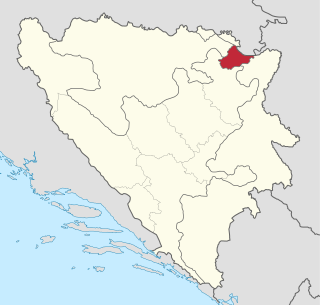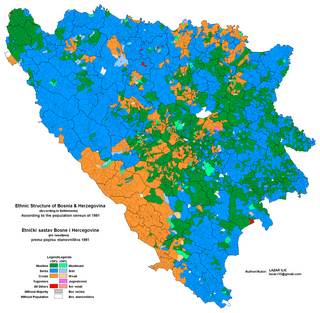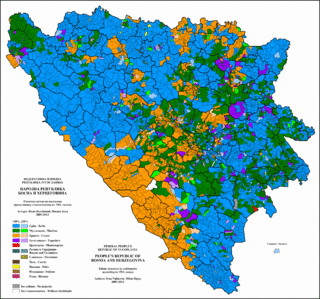
Demographic features of the population of Bosnia and Herzegovina include population density, ethnicity, education level, health of the populace, economic status, religious affiliations and other aspects of the population.

"Muslims" is a designation for the ethnoreligious group of Serbo-Croatian-speaking Muslims and people of Muslim heritage, inhabiting mostly the territory of the former Socialist Federal Republic of Yugoslavia. The term, adopted in the 1971 Constitution of Yugoslavia, groups together a number of distinct South Slavic communities of Islamic ethnocultural tradition. Prior to 1993, a vast majority of present-day Bosniaks self-identified as ethnic Muslims, along with some smaller groups of different ethnicity, such as Gorani and Torbeši. This designation did not include Yugoslav non-Slavic Muslims, such as Turks, some Romani people and majority of Albanians.

Brčko District, officially the Brčko District of Bosnia and Herzegovina, is a self-governing administrative unit in north-eastern Bosnia and Herzegovina.

This article is about the Demographic history of Bosnia and Herzegovina, and deals with the country's documented demographics over time. For an overview of the various ethnic groups and their historical development, see Ethnic groups in Bosnia and Herzegovina.

Mrkonjić Grad is a town and municipality in Republika Srpska, Bosnia and Herzegovina. It is located in the Bosanska Krajina region, between Banja Luka and Jajce. As of 2013, the municipality has a population of 16,671 inhabitants, while the town of Mrkonjić Grad has a population of 7,915 inhabitants.

The Republic of Bosnia and Herzegovina was a state in Southeastern Europe, existing from 1992 to 1995. It is the direct legal predecessor to the modern-day state of Bosnia and Herzegovina.

The Socialist Republic of Bosnia and Herzegovina, commonly referred to as Socialist Bosnia or simply Bosnia, was one of the six constituent federal states forming the Socialist Federal Republic of Yugoslavia. It was a predecessor of the modern-day Bosnia and Herzegovina, existing between 1945 and 1992, under a number of different formal names, including Democratic Bosnia and Herzegovina (1943–1946) and People's Republic of Bosnia and Herzegovina (1946–1963).

The 1991 population census in Bosnia and Herzegovina was the last census of the population undertaken in the Socialist Republic of Bosnia and Herzegovina before the Bosnian War. It was conducted during the final week of March 1991. For the 1991 census there were 109 municipalities of which ten were part of Sarajevo.

The Croats of Bosnia and Herzegovina, often referred to as Bosnian Croats or Herzegovinian Croats, are native and the third most populous ethnic group in Bosnia and Herzegovina, after Bosniaks and Serbs, and are one of the constitutive nations of Bosnia and Herzegovina. Croats of Bosnia and Herzegovina have made significant contributions to the culture of Bosnia and Herzegovina. Most Croats declare themselves Catholics and speakers of the Croatian language.
The 1953 population census in Bosnia and Herzegovina was the second population census of the Socialist Federal Republic of Yugoslavia took place on March 31, 1953. The administrative organization of Bosnia and Herzegovina (51.221 km2) was identical to the first census in the socialist Yugoslavia (1948), apart from the fact that the Odžak district had been abolished and merged with the district of Modriča.
This is a survey of the postage stamps and postal history of Bosnia and Herzegovina.
Brezovo Polje is a town in north-eastern Bosnia and Herzegovina and is located within the Brčko District.
Kestenovac is a village in Croatia. It has a population of 39. It has an area of 3.3 km2 and around 70 buildings.
Ključ is a village in the municipality of Gacko, Republika Srpska, Bosnia and Herzegovina.
Ponijevo is a village in the municipality of Žepče, Bosnia and Herzegovina. Historical records show that the village has been inhabited since the neolithic. The modern Ponijevo is associated to foundation of a catholic parish in the village in the 19th century, and the migrations of Croats from Dalmatia and Herzegovina to this region during this period, as well as the migrations that ensued after the most recent Bosnian war.
The 1948 population census in Bosnia and Herzegovina was the seventh census of the population of Bosnia and Herzegovina. The Socialist Federal Republic of Yugoslavia conducted a population census on 15 March 1948. On the territory of Socialist Republic of Bosnia and Herzegovina 2,565,277 persons lived.

The 1961 population census in Bosnia and Herzegovina was the ninth census of the population of Bosnia and Herzegovina. The Socialist Federal Republic of Yugoslavia conducted a population census on 31 March 1961. 3,277,935 people populated the territory of Socialist Republic of Bosnia and Herzegovina.
Bušević is a village in Croatia.

Donji Štrbci is a village in Croatia.
Begluci is a village in Croatia.












